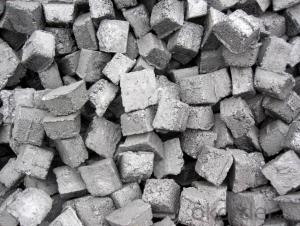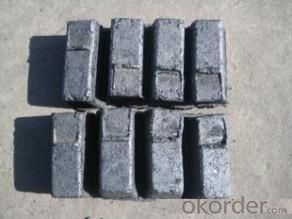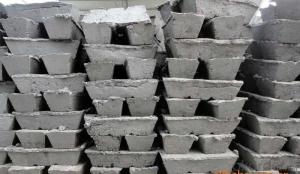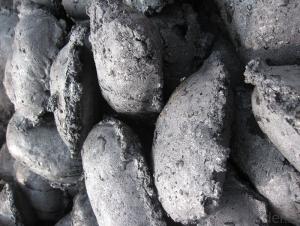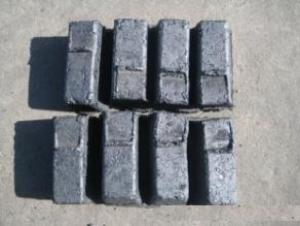Good Quality Low Ash Carbon Electrode Paste -Ash4
- Loading Port:
- Lianyungang
- Payment Terms:
- TT OR LC
- Min Order Qty:
- 20 m.t.
- Supply Capability:
- 2000 m.t./month
OKorder Service Pledge
OKorder Financial Service
You Might Also Like
Good Quality Low Ash Carbon Electrode Paste -Ash4
Usage
Electrode paste is used in closed electric smelting furnace as continuous self-baking electrode to produce calcium carbide, ferroalloy and so on. During the furnace operation, electrode paste acts as current conductor.
Product Description
Carbon Electrode Paste is a self-baking electrode used in submerged arc furnaces for delivering power to the charge mix. Electrode Paste is added to the top of the electrode column in either cylindrical or briquette form. As the paste moves down the electrode column the temperature increase causes the paste to melt and subsequently bake forming a block of electrically conductive carbon. Electrode Paste is essentially a mix of Electrically Calcined Anthracite (ECA) or Calcined Petroleum Coke (CPC) with Coal Tar Pitch.
Features
1. Lower ash content;
2. Acurate dosing and stable volatile content;
3. Good electric and thermal conductivity and the sintering speed apropriate to that of consumption of working end;
4. Smelting at lower temperature with certain fluidity and homogeneous composition;
5. High resistance to high temperature, oxidation and thermal shock, low resistivity and high mechanical strength after sintering.
Graphite/Carbon Electrode Paste Specification
parameter unit gurantee value
Ash.( % ) 4.0 max5.0 max 6.0 max 7.0 max 9.0 max11.0 max
V.M (%) 12.0-15.512.0-15.5 12.0-15.5 9.5-13.5 11.5-15.511.5-15.5
Compress Strength. 18.0 min17 min 15.7 min 19.6 min 19.6 min19.6 min
Specific Resistance 65 max68 max 75 max 80 max 90 max90 max
Bulk Density 1.38 min1.38 min1.38 min 1.38 min 1.38 min1.38 min
Picture
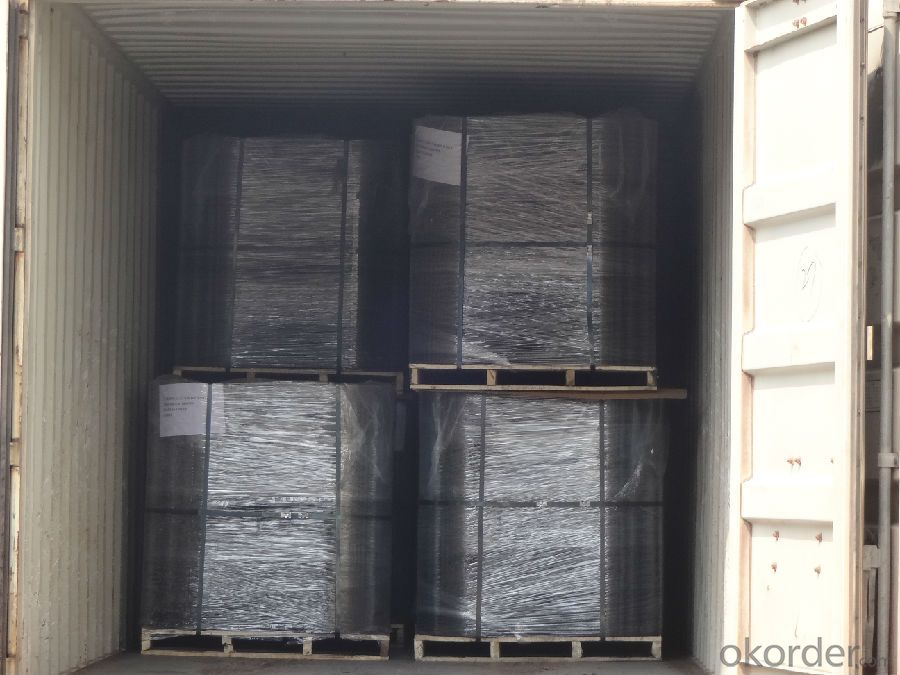
- Q: What are the benefits of carbon fiber?
- Carbon fiber (carbon fiber, referred to as CF) is a new kind of fiber material with high strength and high modulus fiber with carbon content of more than 95%. It is a flaky graphite, microcrystalline and other organic fibers stacked along the axial direction of the fiber, obtained by carbonization and graphitization of microcrystalline graphite material.
- Q: What are the impacts of carbon emissions on the spread of infectious diseases?
- Carbon emissions have a significant impact on the spread of infectious diseases. The burning of fossil fuels, such as coal, oil, and natural gas, releases large amounts of carbon dioxide (CO2) and other greenhouse gases into the atmosphere. These emissions contribute to climate change, which in turn affects the distribution and transmission of various infectious diseases. One of the main ways carbon emissions influence the spread of infectious diseases is through changes in temperature. Rising global temperatures create favorable conditions for the survival and proliferation of disease-causing agents and their vectors. For example, warmer temperatures can expand the geographic range of disease-carrying insects like mosquitoes, which are responsible for transmitting diseases such as malaria, dengue fever, and Zika virus. Additionally, climate change caused by carbon emissions can disrupt ecosystems and alter the behavior of animals that serve as hosts or reservoirs for infectious diseases. Changes in migration patterns, breeding cycles, and hibernation can affect the dynamics of diseases, making them more difficult to control. For instance, warmer temperatures may lead to the expansion of tick populations, increasing the risk of tick-borne diseases like Lyme disease. Furthermore, carbon emissions contribute to air pollution, which has adverse effects on respiratory health. Pollutants like particulate matter and nitrogen dioxide can weaken the immune system and make individuals more susceptible to respiratory infections, including influenza and pneumonia. These pollutants also exacerbate the severity of respiratory symptoms in individuals already infected with respiratory diseases. The impacts of carbon emissions on the spread of infectious diseases are not limited to direct effects on humans. Changes in climate patterns can disrupt agricultural systems, leading to food insecurity and malnutrition. These conditions weaken the immune systems of vulnerable populations, making them more susceptible to infectious diseases. It is important to recognize the connection between carbon emissions and the spread of infectious diseases in order to mitigate their impacts. Reducing carbon emissions through transitioning to cleaner energy sources and implementing sustainable practices can help mitigate climate change and limit the expansion of disease vectors. Additionally, investing in public health infrastructure and surveillance systems can enhance our ability to detect and respond to outbreaks, minimizing their spread and impact on human populations.
- Q: What is methane?
- Methane is a colorless and odorless gas that is the primary component of natural gas. It is the simplest hydrocarbon, consisting of one carbon atom and four hydrogen atoms, and has the chemical formula CH4. Methane is highly flammable and burns in the presence of oxygen, releasing carbon dioxide and water vapor. It is produced naturally through the decomposition of organic matter by bacteria in environments with little or no oxygen, such as swamps, marshes, and landfills. Methane is also produced by livestock, such as cows, as a byproduct of their digestive process. It is considered a greenhouse gas and a major contributor to climate change due to its ability to trap heat in the Earth's atmosphere. Methane is widely used as a fuel for heating and cooking, as well as in industrial processes and electricity generation.
- Q: How does carbon affect the formation of tsunamis?
- Carbon does not directly affect the formation of tsunamis. Tsunamis are primarily caused by underwater earthquakes, volcanic eruptions, or landslides. Carbon, in the form of carbon dioxide (CO2), is a greenhouse gas that contributes to global warming and climate change. While carbon emissions and the resulting climate change can impact ocean temperatures and sea levels, they do not directly trigger the formation of tsunamis. However, it is important to note that climate change can indirectly influence the intensity and frequency of natural disasters, including tsunamis, through its impact on oceanic and atmospheric conditions. Rising sea levels caused by melting glaciers and polar ice can potentially increase the destructive power of tsunamis by allowing them to reach further inland. Additionally, climate change can affect the frequency and magnitude of earthquakes and volcanic activity, which are the primary triggers of tsunamis. Therefore, while carbon emissions do not directly affect tsunami formation, their impact on climate change can indirectly influence the factors that contribute to the occurrence and severity of tsunamis.
- Q: How is carbon used in the production of paints and pigments?
- Due to its unique properties and versatility, carbon finds wide application in the production of paints and pigments. A primary utilization of carbon is seen in the production of carbon black, which is a fine powder derived from the incomplete combustion of hydrocarbons like coal tar, petroleum, or natural gas. Carbon black proves highly useful as a pigment in various paints, inks, and coatings. The deep shade of carbon black makes it a popular choice for creating intense black pigmentation in paints and pigments. Its exceptional stability and resistance to fading ensure the color remains vibrant over time. Furthermore, carbon black exhibits excellent opacity, effectively covering other colors and providing a solid foundation for further pigmentation. In addition to its role as a pigment, carbon black enhances the durability and performance of paints and coatings. It acts as a reinforcing agent, elevating the mechanical properties of the final product. By increasing strength, toughness, and resistance to abrasion, carbon black ensures the paint or coating is long-lasting and resistant to wear and tear. Moreover, carbon black possesses electrical conductivity, making it a valuable component in specialty coatings, including anti-static coatings and electromagnetic shielding coatings. These coatings are critical in industries such as electronics, automotive, and aerospace, where electrical conductivity or protection against electromagnetic interference is essential. Besides carbon black, other forms of carbon, such as graphite and carbon nanotubes, find application in the production of specialized paints and pigments. Graphite is commonly utilized in high-performance coatings due to its lubricating properties and resistance to extreme temperatures. On the other hand, carbon nanotubes offer unique optical, electrical, and mechanical properties, making them suitable for advanced coatings and pigments in various applications. In conclusion, carbon plays a vital role in the production of paints and pigments by providing intense black pigmentation, enhancing durability, and offering unique properties for specialized coatings. Its versatility as an ingredient ensures the production of high-quality, long-lasting, and visually appealing products in the paint and pigment industry.
- Q: What is carbon black dye?
- Carbon black dye is a pigment derived from the incomplete combustion of hydrocarbons, commonly used in various industries, including the production of inks, plastics, rubber, and coatings.
- Q: What are the consequences of increased carbon emissions on political stability?
- Political stability can be significantly affected by the increase in carbon emissions. Environmental challenges and natural disasters are intensified as a result. The frequency and intensity of extreme weather events, such as hurricanes, droughts, and flooding, are increased due to carbon emissions contributing to global warming. These disasters have the potential to displace communities, destroy infrastructure, and result in loss of life, all of which can destabilize societies. Furthermore, the economic consequences of increased carbon emissions can also lead to political instability. Climate change affects vital sectors such as agriculture, water resources, and energy production, causing economic disturbances, unemployment, and rising food prices. These hardships can fuel social unrest, protests, and even conflicts, particularly in countries heavily reliant on these sectors for their livelihoods. Moreover, increased carbon emissions can exacerbate existing social and political tensions. Vulnerable populations, including marginalized groups and communities in developing countries, are disproportionately affected by climate change. This inequality can worsen social disparities, increase social unrest, and result in political instability as marginalized communities demand action and justice. Additionally, addressing the global issue of climate change requires international cooperation and agreements. However, increased carbon emissions can strain diplomatic relations, especially between countries with differing views on climate action. Disagreements over carbon reduction targets, carbon trading mechanisms, and financial contributions can create diplomatic tensions and hinder global cooperation, ultimately impacting political stability. In conclusion, the consequences of increased carbon emissions have wide-ranging effects on political stability. From environmental challenges and natural disasters to economic disturbances and social tensions, carbon emissions strain societies and governments. To ensure political stability, it is crucial to make global efforts to reduce carbon emissions and mitigate the impacts of climate change.
- Q: How does carbon affect the ozone layer?
- Carbon does not directly affect the ozone layer. However, certain carbon compounds, such as chlorofluorocarbons (CFCs), can release chlorine atoms when they reach the stratosphere. These chlorine atoms can then react with ozone molecules, leading to the depletion of the ozone layer.
- Q: What is carbon sequestration?
- Carbon sequestration is the process by which carbon dioxide (CO2) is captured from the atmosphere and stored for an extended period of time, preventing it from being released and contributing to climate change. This technique aims to reduce the concentration of CO2 in the atmosphere, as this greenhouse gas is a major driver of global warming. Carbon sequestration can occur naturally through biological processes, such as photosynthesis in plants and algae, or it can be achieved through various artificial methods. Natural carbon sequestration occurs when plants, trees, and other vegetation absorb CO2 during photosynthesis and store it in their tissues. This process, known as terrestrial sequestration, plays a crucial role in reducing atmospheric CO2 levels. Additionally, oceans also act as a significant sink for CO2, absorbing and storing vast amounts of it. This is referred to as oceanic sequestration. Artificial carbon sequestration techniques involve capturing CO2 emissions from industrial processes, power plants, and other sources before they are released into the atmosphere. There are several methods for carbon capture, including pre-combustion capture, post-combustion capture, and oxy-fuel combustion. Once the CO2 is captured, it can be transported and stored underground in geological formations, such as depleted oil and gas fields or saline aquifers. This process is commonly known as carbon capture and storage (CCS) or carbon capture utilization and storage (CCUS). Carbon sequestration has gained significant attention due to its potential to mitigate climate change. By reducing the amount of CO2 in the atmosphere, it helps to slow down the pace of global warming and reduce the impacts of climate change. It is considered to be a crucial part of the broader strategy to achieve net-zero emissions, as it not only reduces future emissions but also removes CO2 that has already been emitted. However, carbon sequestration is not a silver bullet solution to climate change. It should be seen as a complementary approach to other mitigation efforts, such as transitioning to renewable energy sources and improving energy efficiency. Additionally, the long-term storage of CO2 requires careful monitoring and management to ensure its effectiveness and prevent any leakage or environmental risks. Overall, carbon sequestration is a vital tool in the fight against climate change, offering the potential to reduce greenhouse gas emissions and contribute to a more sustainable future.
- Q: How does carbon impact the availability of sustainable development policies?
- Carbon impacts the availability of sustainable development policies by directly contributing to climate change. The excessive emission of carbon dioxide and other greenhouse gases from human activities leads to global warming, which in turn affects natural resources, ecosystems, and communities. To mitigate the negative impacts of carbon, sustainable development policies aim to reduce carbon emissions, promote renewable energy sources, and encourage sustainable practices. By addressing carbon emissions, these policies help create a more sustainable future by preserving resources, minimizing environmental degradation, and fostering social and economic well-being.
Send your message to us
Good Quality Low Ash Carbon Electrode Paste -Ash4
- Loading Port:
- Lianyungang
- Payment Terms:
- TT OR LC
- Min Order Qty:
- 20 m.t.
- Supply Capability:
- 2000 m.t./month
OKorder Service Pledge
OKorder Financial Service
Similar products
Hot products
Hot Searches
